For this week’s post I am in Belgravia, an area of London I have not covered before, however this is a return visit to check on a pub last photographed in 1985. This is the Horse and Groom in Groom Place, Belgravia.

The same pub today, unfortunately closed whilst we are still under Covid restrictions.
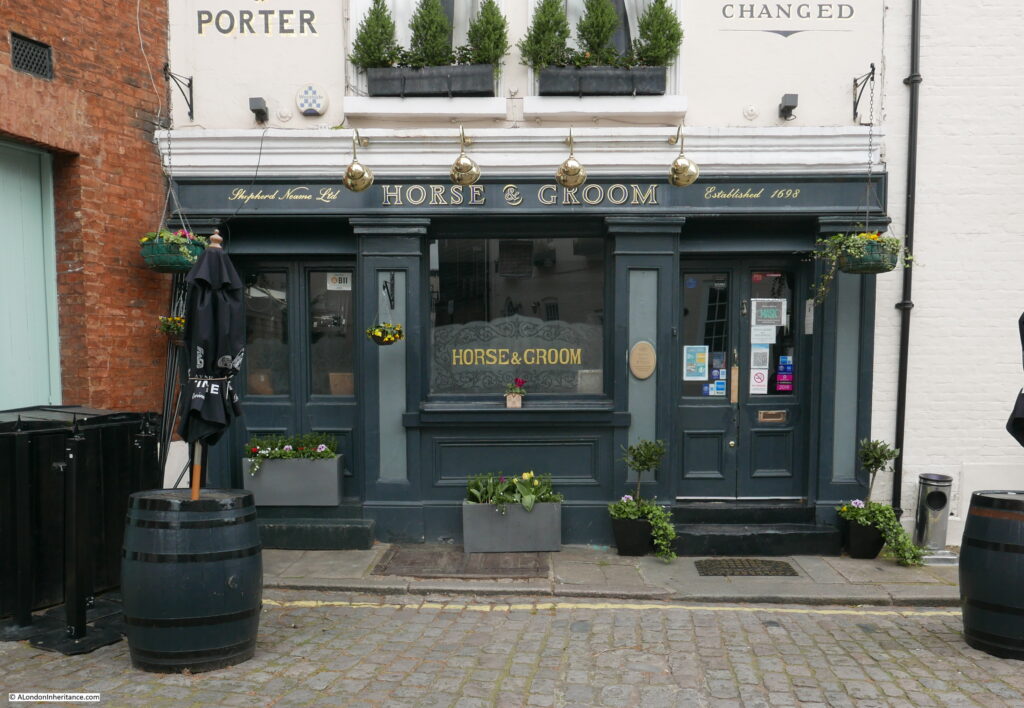
The Horse and Groom in Groom Place is one of London’s ‘mews’ pubs. Not on a main street, rather tucked away in one of the small side streets that were designed for servicing the large houses on the main streets, for stabling the horses of their residents, providing (when originally built) lower cost housing and for some small industrial purposes.
Chester Street and Chapel Street run from Grosvenor Place to Upper Belgrave Street and Belgrave Square. Groom Place runs between Chester and Chapel Streets. I have highlighted the location in the following map, with a red circle marking the location of the Horse and Groom on the corner of Groom Place (Map © OpenStreetMap contributors):
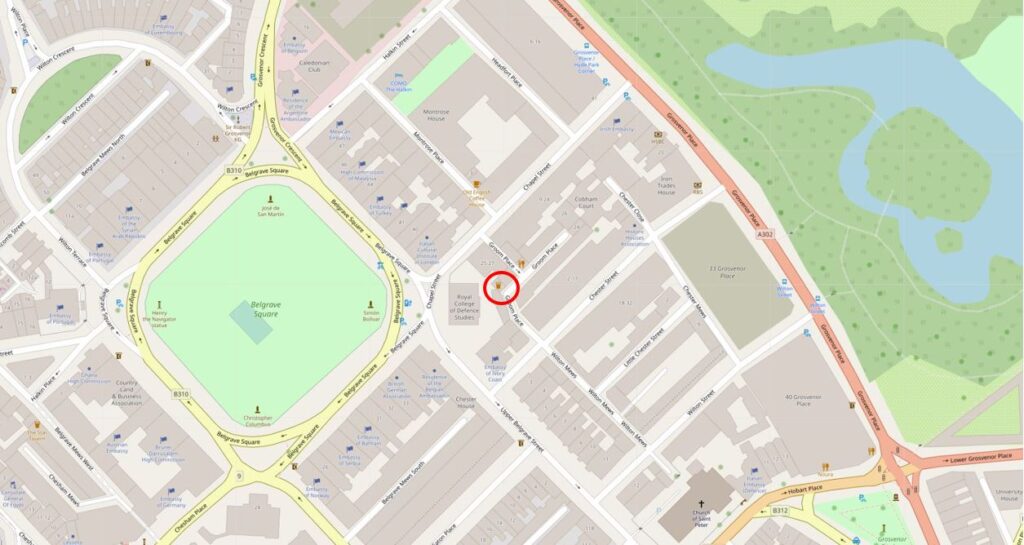
The green and blue to the right of the above map are the gardens and lake of Buckingham Palace Gardens.
This area of London is relatively new, having been built during the early decades of the 19th century.
Horwood’s map of 1799 shows some early building along Grosvenor Place, and the first houses in Chapel Street, however the rest is still field (unfortunately this area was on the edge of the page of my copy of Horwood’s map, so only part of the fields are shown).

Smith’s New Plan of London dating from 1816 provides a better view of the area (but without the level of detail of Horwood’s map), and shows the Queen’s Gardens (what are now Buckingham Palace Gardens), with Grosvenor Place to the left of the garden with building now along the street and starting to reach into the fields behind.

There are some differences with Horwood’s earlier map. The above map shows a pond just below the word “Chapel” which does not appear on the more detailed Horwood map. There were several ponds in the area as Rocque’s map of 1746 show these, and the area was known to have been poorly drained.
There is an interesting detail in the above map. look to the left of the open space with the word “Chapel”, and you will see a wavy line running down from Knightsbridge. This was the River Westbourne when it still ran through what remained of the fields of west London, running down from the Serpentine in Hyde Park, which originally used the Westbourne as a water source, before the river became too polluted.
The ponds and the River Westbourne provide some clues as to the state of the area that would become Belgravia. In Old and New London (1878), Edward Walford writes:
“There was a time, and not so very distant in the lapse of ages, when much of Belgravia, and other parts of the valley bordering upon London was a ‘lagoon of the Thames’; indeed, the clayey swamp in this particular region retained so much water that no one would build there. At length, Mr Thomas Cubitt found the strata to consist of gravel and clay, of inconsiderable depth.
The clay he removed and burned into bricks, and by building upon the substratum of gravel, he converted this spot from the most unhealthy to one of the most healthy in the metropolis, in spite of the fact that the surface is but a few feet above the level of the River Thames at high water, during spring-tides”.
Thomas Cubitt started developing Belgravia in 1824 on behalf of the owner of the land, Richard Grosvenor, the 2nd Marquess of Westminster. As well as removing the clay, Harold Clunn in the Face of London (1932) states that the ground level was also made up by the use of the soil excavated to form the St Katherine Docks, however I suspect this was more towards the south of the estate around Pimlico rather than in the area of Groom Place.
The land consisted of what had been known as the Five Fields, an area of around 430 acres that stretched from roughly Hyde Park Corner down to Pimlico and Chelsea. The area was once part of the ancient Manor of Ebury, and in 1677 it came into the possession of the Grosvenor family through the marriage of Sir Thomas Grosvenor to Mary Davies who owned Ebury Farm with the associated land.
The name Ebury can still be found today with Ebury Street to the south of Belgravia, near Victoria Station, along with the nearby Ebury Square. Ebury Street follows the rough alignment of an old street called the Five Fields, and the original location of Ebury Farm (also called Avery Farm on early maps) was close to Ebury Square and Victoria Coach Station.
The name Belgravia comes from the village of Belgrave in Cheshire, which is part of one of the estates owned by the Duke of Westminster.
Returning to Groom Place, and where there is a branch leading up to Chapel Street, was, in 1985, L. Binelli, General Store:

The General Stores have gone, the crooked corner door has been straightened, a window added to the first floor, and the building is now home to Muse – a restaurant run by the chef Tom Aikens:

A bit of detail from the 1985 photo – 1980s corner shops always seemed to have their windows stuffed with the products you could buy in the shop, and frequently a Lyons Maid ice cream sign.
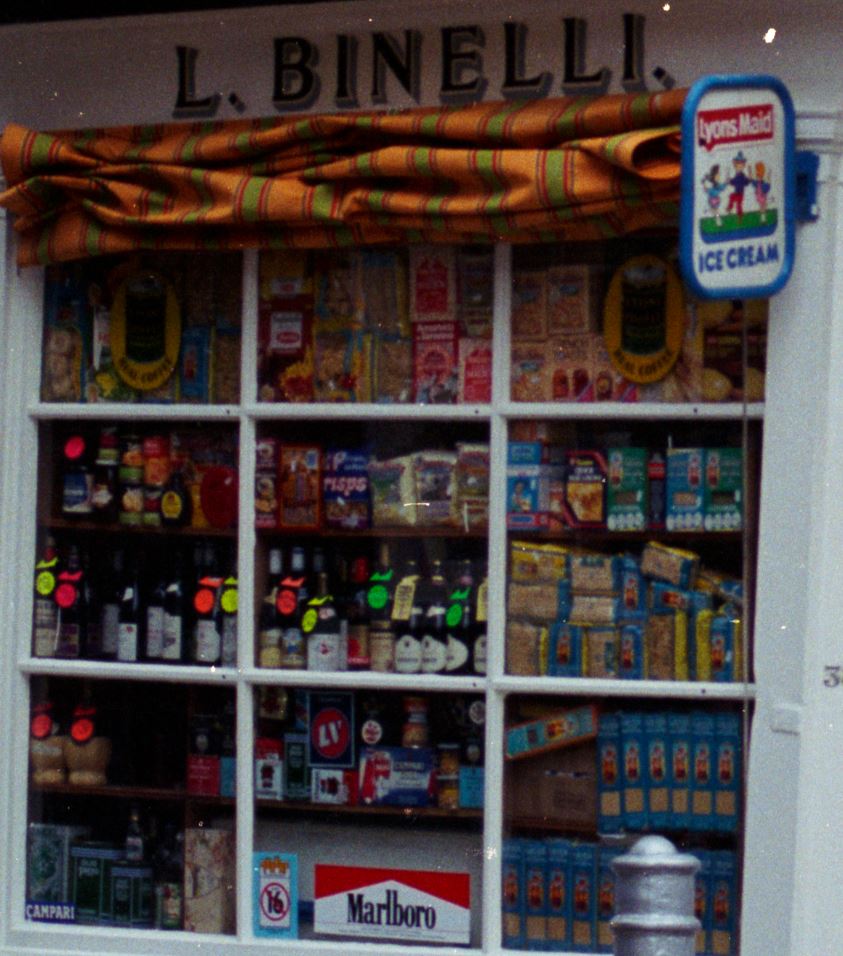
Walking up to Chapel Street, and we can see the original name of Groom Place:

Chapel Place was the name from the time the area was built up until the early 20th century (I cannot find the exact date of the name change).
Perhaps the name change was to mirror part of the name of the Horse and Groom pub, or to recall one of the jobs that would have been based here. It may have been changed to avoid confusion with another Chapel Place, between Oxford Street and Henrietta Place, which still exists today. The need to avoid confusion with other streets of the same name was a frequent justification for name changes.
Given the history of the area, there is one thing I am confused about with the Horse and Groom. Just above the door, the pub advertises “established 1698”.

This date was not on the original 1985 photo, and given that the area was built during the first decades of the 19th century, 1698 seems a considerable time before this development and was a time when the area was mainly fields.
The first reference I can find to the Horse and Groom dates from the 15th March 1852, when a rather cryptic paragraph in the Morning Advertiser states “Horse and Groom, Chapel-place, Belgrave-square. Joseph Prior applied for this licence and Mr Wire appeared in opposition – Licence refused”.
Why Joseph Prior was unsuitable for the licence to run the Horse and Groom and what caused Mr Wire to object is not recorded, but it does confirm that the Horse and Groom was a working pub in 1852, and therefore probably dates to when Chapel Place was constructed. The name of the pub refers to the main activity that took place in Chapel Place.
We can get an idea of how the area was developing from an advert for the Horse and Groom in the Morning Advertiser on the 18th June 1868:
“HORSE AND GROOM, 3 CHAPEL-PLACE, BELGRAVE-SQUARE, together with the GOODWILL AND BENEFICIAL POSSESSION. The premises are of recent elevation, combining all the requisites for carrying on the excellent full-priced trade this house is noted for. Protected, unopposed, and with the certainty of additional trade, arising from the countless mansions that are now being erected in Grosvenor-place and the vicinity, render this property comparatively speaking matchless”.
Looking down Groom Place from Chester Street:
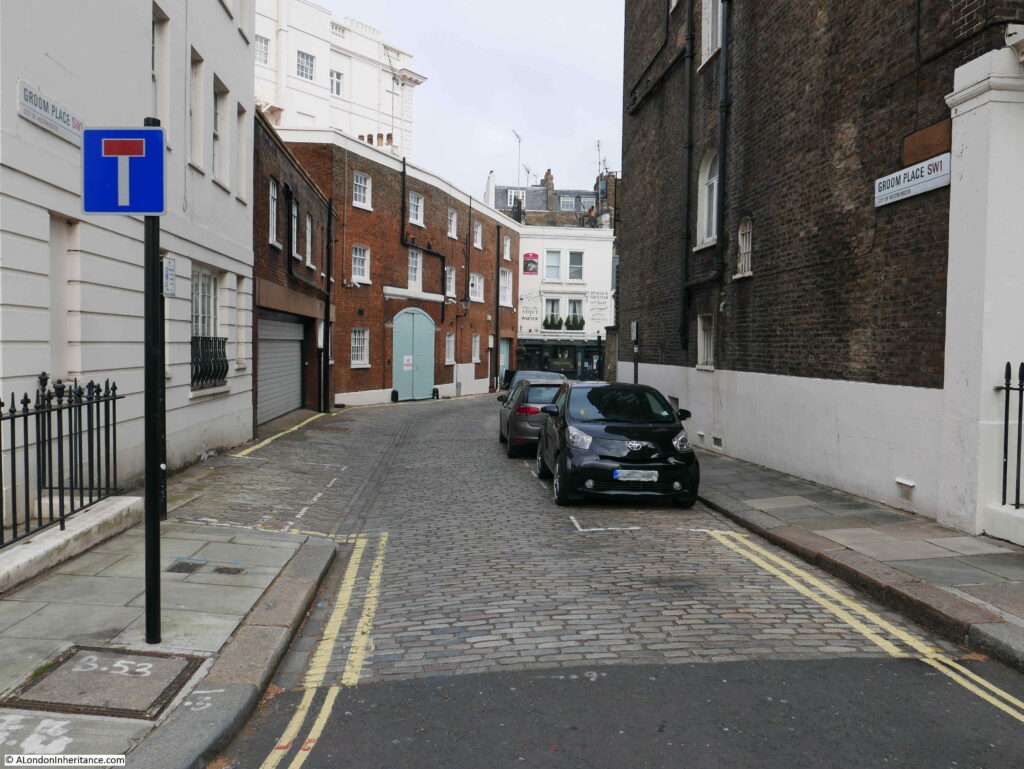
The large building on the left in the above photo was Bryant’s Second-hand Saddlery, Harness and Horse Clothing Depot, established in the early 1830s.
The following photo shows the full building of the Horse and Groom and answers the question regarding the age of the pub.
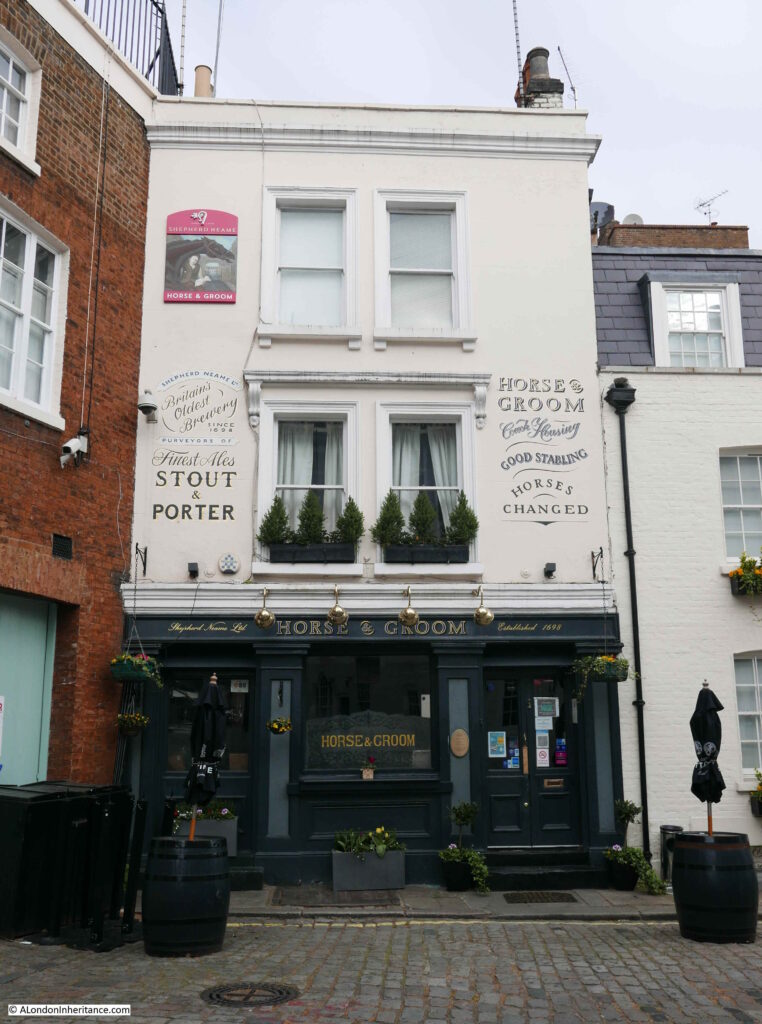
If you look to the left of the windows on the first floor is writing stating that Shepherd Neame are Britain’s oldest brwery, and that they were established in 1698, so the sign above the door relates to the brewery, not the pub.
I can reasonably confidently date the pub to when Chapel Place was built, around the late 1820s / early 1830s.
The buildings housing the depot for all things horse related:
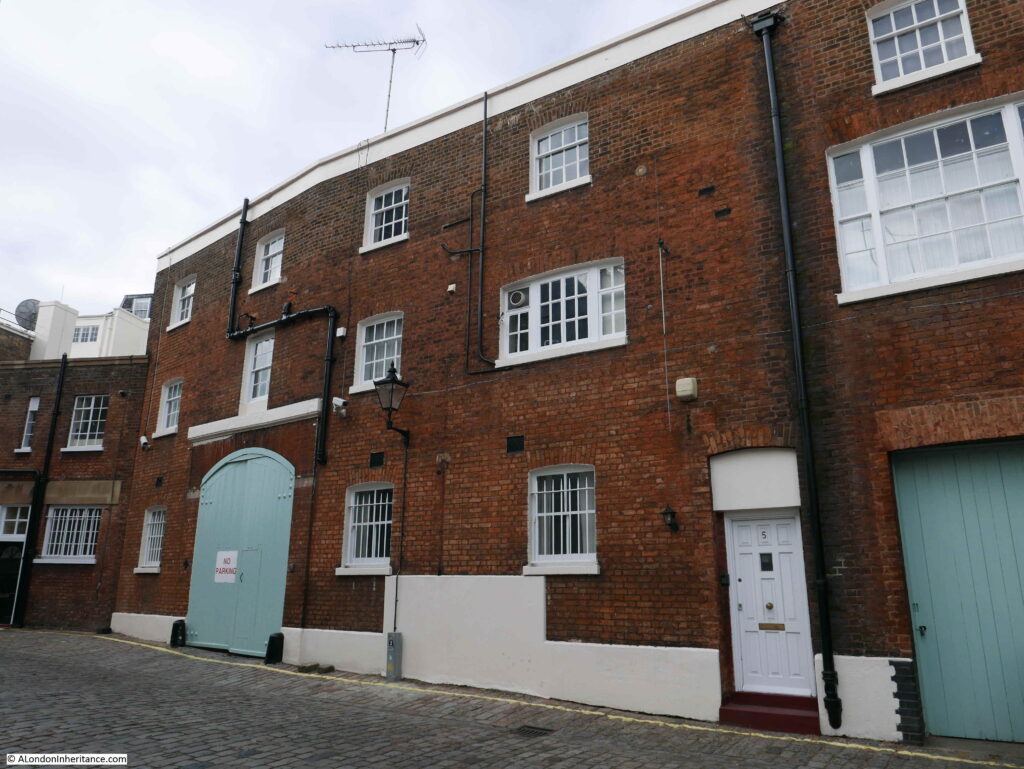
The following photo is from outside the Horse and Groom, looking back up Groom Place towards Chester Street.
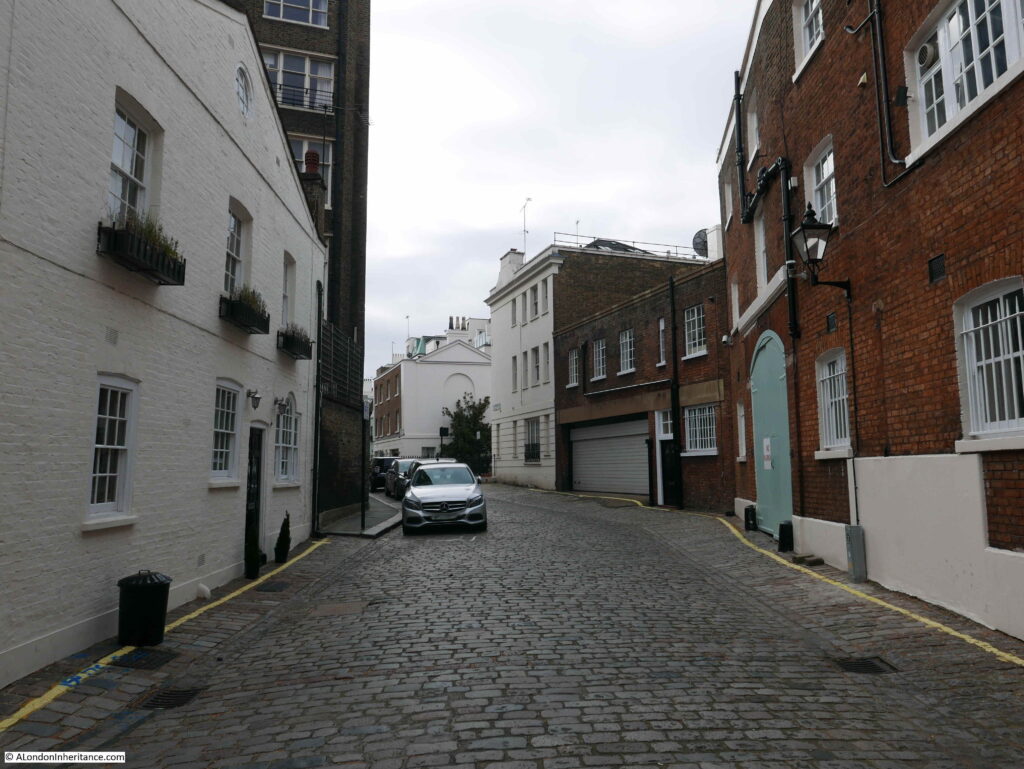
I love looking for evidence in the built streets of London remaining from the time before they were built.
I have no evidence to confim this, but as shown in the above photo, the central part of Groom Place is in a dip, with the parts of the street going to Chapel and Chester Street rising in height.
The early maps show a pond roughly in the area of Groom Place, and perhaps when laying out the streets, the site of an old pond would not be where you want to build the expensive houses, so the smaller houses, and those occupied by stables were built on the site of the old pond.
The price of properties in Groom Place reflect the price of Belgravia in general. There is currently a two floor flat in Groom Place for sale for £2.795 Million. The covered Bentley in the following photo highlights the money you need to live in the area.
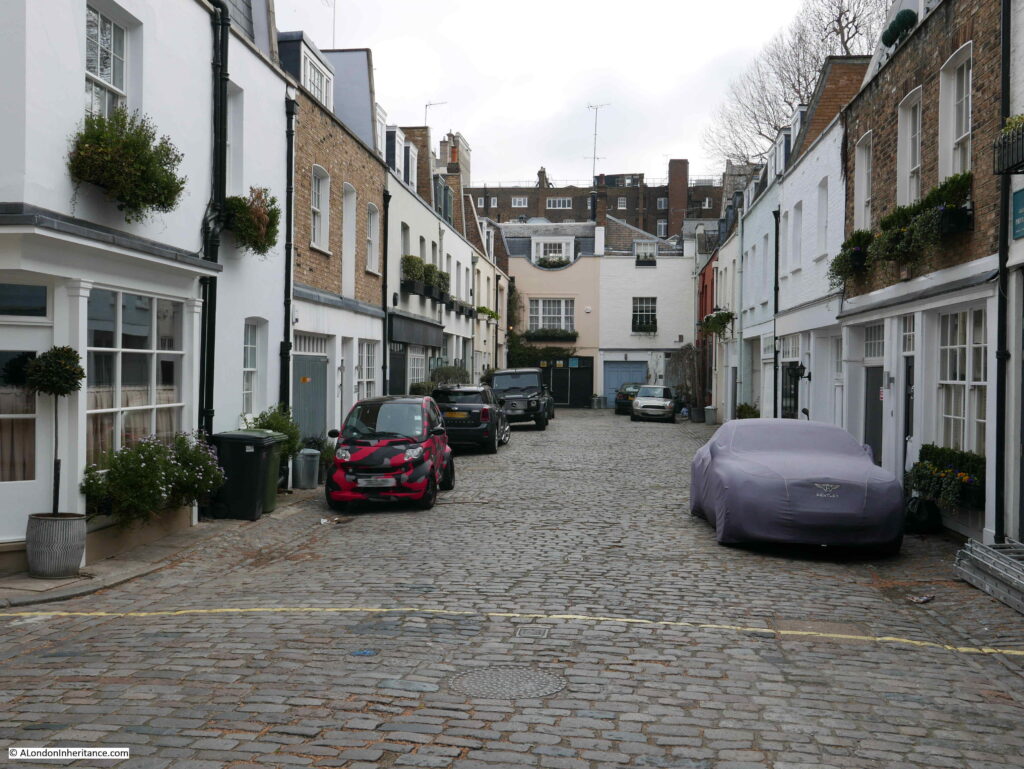
A final look back along Groom Place from just outside the old Binelli General Store:

Belgravia may not appear too interesting at first glance. Rows of similar terrace houses, foreign embassies, buildings owned offshore as investments and empty for much of the time, however look a bit closer and there are so many interesting little side streets and interesting buildings. The old Five Fields is just below the surface and it is still possible to trace some of the old roads and locations of the Five Fields and Ebury Farm which have transformed into the Belgravia we see today. There is plenty more to explore, including more mews pubs.
Thankfully the Horse and Groom is still there, although redecorated since 1985. It is a really good pub, and although great at any time of year, a visit in the winter and leaving after dark, into Groom Place can, just for a moment, recall what this part of Belgravia may have been like in the 19th century.

A great read thank you, what a lovely area and a shame buildings are empty
Very informative and I’ll be looking to visit the Horse and Groom, once we’re back to normal
Thank you what an interesting and well researched. With you 100% about bland embassies will definitely reconsider the area now based in your research and hopefully visit the pub soon.
1698 was the date of the founding of Shepherd Neame brewery, from Faversham Kent. They even have a beer called 1698. You can see the red sign for the brewery top left of one of your pictures.
Thank you – as always very interesting. Shepheard Neame is trying it on slightly – the Three Tuns brewery in Bishops Castle, Shropshire, claims to having been brewing without interruption since the Civil War, giving its foundation as 1642. If this is true, it’s half a century older.
Floods are interesting. The Tyburn flows under Piccadilly a little to the east, at the edge of the Smith’s map detail and used to flood badly above the Stone Bridge at the bottom of Brick Street. This was made worse by the illegal sewers for grey water plumbed into the Tyburn’s feeder-pipes by property developers and householders to the north and east in the late 17th and early 18th centuries. In 1726 the Moroccan ambassador’s coach was assailed by floodwater there and almost overturned.
And the lettering to the left of the pub name is ‘Shepherd Neame Ltd’ to be read with the date to the right of the pub name ‘Established 1698’. Thank you for an interesting read.
Someone above spotted what I was going to say about the date being to do with Shepherd Neame’s foundation rather than the building – although I think they should be made to make this clear! I had a drink a couple of times there in the late 80s when I worked near the Bag of Nails pub in Buckingham Palace Road. However as there were usually a few of us from the office the Horse and Groom was a bit confined in size, so we used one of the many other hostelries nearby, such as the Talbot, Pig and Whistle and Star Tavern, all of which are or were yards from Belgrave Square. Rarely did we go into the Bag of Nails though – too close to the office!
I used to work on Grosvenor Place, and would often frequent the Horse and Groom after work. The Republic of Ireland’s embassy is just around the corner, and I would often hear Irish accents amongst the punters in the pub. The staff were very nice, and as you say, a great place in the winter to huddle in before heading out along the cobbles.
Brian Epstein lived and died around the cotner at 24 Chapel Street. The Horse & Groom was his local where he met with the Beatles.
Wonderful! I love your point about the dip and the pond. Thank you!
The river goes under the road at – yes – Knightsbridge! Kinnerton Street – another street of mews houses on the other side of Grosvenor Crescent – follows its course south towards the River…. heartbreakingly now terribly damaged by rebuilding. I am so glad you have recorded THIS little corner before it is destroyed.
You are absolutely right about rich Victorians not wanting to inhabit damp spots, and leaving those areas for the poor ostlers etc who lived in the upper level of those little mews houses when horses occupied the ground floor. lt took a lot of hard work to make a swamp into high class real estate – the landowner has done very well out of it ever since…
Yes I totally agree with you, but what makes you think that the Victorians didn’t want to inhabit damp areas?
Because they thought a) they are unhealthy and b) the water is bound to damage the building in the long term?
I love walking down a secret mews & i love proper old boozers! It would be good to write a blog about mews pubs. There’s a really lovely old pub called the Nag’s Head in Victoria. Real character. Quite a few regulars. (Which I love). Not just tourists all the time. The bar is very low. Looks like the staff are down a hole, they’re so low. No mobile are allowed. (Like the Sam Smith proprietor). They like authentic pubs. So no technology is allowed. Just ‘tipsy’ conversation & a packet of pork scratchings. LOVELY Bring on 17th May!!!!
Whilst living in Knightsbridge in the late 1980’s, I would occasionally nip into The Nags Head on Kinnerton Street; the interior was very much as the one you describe. Could they be one in the same? The music playing was ’40’s, there was a working nickelodeon next the bar! Pretty much just a locals pub; I would sometimes stop in for Sunday lunch with a pint and The Times. Lovely days!
Excellent interesting read
Great read as Vicky said pint and pork scrathings bring it on.
Yes. I’m not sitting in a grubby, seedy car park. I’ll wait until the ‘insides’ are open. I love Sam Smith’s pubs. I live in Holborn. So the Princess Louise, the Lyceum Tavern. I love an Irish pub on Wellington Street called the Coach & Horses. It’s a tiny pub. Family run. Lovely staff. It’s like you’re in someone’s front room. The regulars are nice too. Cheers everone!
Chapel Place was renamed Groom Place on 30th October 1931 as part of the London County Council’s pre-second world war massive street renaming scheme to remove many duplicate and confusing names.
What a fascinating article; thank you.
An excellent piece of research and deduction. Thanks.
Thanks for this thoughtful and well-researched piece. I grew up in a flat on Chester Street in the late 60’s and mid 70’s and my bedroom overlooked the mews. I was woken up many a night at closing time when the punters were leaving roudily including a few broken glasses. I was also a frequent customer at Binelli’s when we ran out of milk, butter, etc. and my mother sent me there in an emergency!
Thanks for this great trip down memory lane.
An amazing read, I have just recently been told that my aunts ran this establishment a very longtime ago, I was wondering is there any possibility of checking records? I welcome any thoughts you may have on this matter.
Thanking you in advance,
Marie Bergin
Thank you for this well researched & informative article. My great grandfather & his brother owned Bryant’s saddlery. Harness & Hanson cab. I am getting back to doing my family history & would appreciate any information you could add, I also was told they were harness & saddle makers to the king! I had rung the Horse & Groom to enquire if I need to book for lunch a few months ago. The landlord was very friendly.
Kind regards.